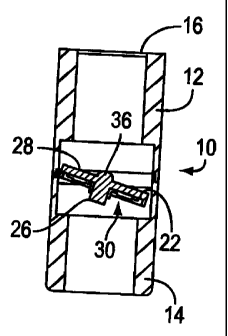Some of the information on this Web page has been provided by external sources. The Government of Canada is not responsible for the accuracy, reliability or currency of the information supplied by external sources. Users wishing to rely upon this information should consult directly with the source of the information. Content provided by external sources is not subject to official languages, privacy and accessibility requirements.
Any discrepancies in the text and image of the Claims and Abstract are due to differing posting times. Text of the Claims and Abstract are posted:
| (12) Patent: | (11) CA 2347190 |
|---|---|
| (54) English Title: | BI-FUNCTIONAL IN-LINE PHONATION VALVE |
| (54) French Title: | VALVE DE PHONATION EN LIGNE BIFONCTIONNELLE |
| Status: | Deemed expired |
| (51) International Patent Classification (IPC): |
|
|---|---|
| (72) Inventors : |
|
| (73) Owners : |
|
| (71) Applicants : |
|
| (74) Agent: | MOFFAT & CO. |
| (74) Associate agent: | |
| (45) Issued: | 2009-06-23 |
| (86) PCT Filing Date: | 1999-10-01 |
| (87) Open to Public Inspection: | 2000-04-20 |
| Examination requested: | 2004-09-10 |
| Availability of licence: | N/A |
| (25) Language of filing: | English |
| Patent Cooperation Treaty (PCT): | Yes |
|---|---|
| (86) PCT Filing Number: | PCT/US1999/022768 |
| (87) International Publication Number: | WO2000/021599 |
| (85) National Entry: | 2001-04-11 |
| (30) Application Priority Data: | ||||||
|---|---|---|---|---|---|---|
|
An in-line phonation valve system (10) including a valve body (12) having
first and second ends (14, 16) through
which gas passes into and out of the valve body (12). The first end (14) is
connectable to a breathing tube connected to a patient's
airway, for passage of gas between the breathing tube and the valve body (12).
The second end (16) of the valve body (12) is
connectable to a gas line. A diaphragm-valve assembly (28) is provided which
includes a one-way valve (30) having a phonation
position permitting gas to pass through said valve body (12) toward said
patient when said patient inhales. The one-way valve
(30) in the phonation position substantially prevents gas from passing through
the valve body (12) when the patient exhales. The
diaphragm-valve assembly (28) is movable out of the phonation position, so as
to permit substantially free flow of gas through
the valve body (12) both toward and away from the patient when the patient
respectively inhales and exhales. The diaphragm-valve
assembly (28) is movable from the phonation position without disconnecting the
first end (14) from the breathing tube and the second
end (16) from the gas line. Preferably, the diaphragm-valve assembly (28) is a
removable cartridge which is replaceable with a
free-flowing ring cartridge insert (42).
Un système de valve (10) de phonation en ligne comprend un corps de valve (12) ayant des première et seconde extrémités (14, 16) par lesquelles un gaz passe dans le corps de valve (12) et hors de celui-ci. La première extrémité (14) est connectable à un tube respiratoire relié à une voie aérienne du patient, permettant le passage du gaz entre le tube respiratoire et le corps de valve (12). La seconde extrémité (16) du corps de valve (12) est connectable à un conduit de gaz. Un ensemble diaphragme-valve (28) est prévu lequel comprend une valve unidirectionnelle (30) ayant une position de phonation permettant au gaz de passer à travers ledit corps de valve (12) vers le patient lorsque celui-ci inhale. La valve unidirectionnelle (30) dans la position de phonation empêche sensiblement le passage du gaz à travers le corps de valve (12) lorsque le patient exhale. L'ensemble diaphragme-valve (28) quitte sa position de phonation pour permettre l'écoulement sensiblement libre de gaz à travers le corps de valve (12) à la fois vers et à l'opposé du patient lorsque celui-ci respectivement inhale et exhale. L'ensemble diaphragme-valve (28) quitte sa position de phonation sans débranchement de la première extrémité (14) du tube respiratoire et de la seconde extrémité (16) du conduit de gaz. De préférence, l'ensemble diaphragme-valve (28) est une cartouche amovible pouvant être remplacée par un insert cartouche annulaire (42) à écoulement libre.
Note: Claims are shown in the official language in which they were submitted.
Note: Descriptions are shown in the official language in which they were submitted.

For a clearer understanding of the status of the application/patent presented on this page, the site Disclaimer , as well as the definitions for Patent , Administrative Status , Maintenance Fee and Payment History should be consulted.
| Title | Date |
|---|---|
| Forecasted Issue Date | 2009-06-23 |
| (86) PCT Filing Date | 1999-10-01 |
| (87) PCT Publication Date | 2000-04-20 |
| (85) National Entry | 2001-04-11 |
| Examination Requested | 2004-09-10 |
| (45) Issued | 2009-06-23 |
| Deemed Expired | 2017-10-02 |
There is no abandonment history.
Note: Records showing the ownership history in alphabetical order.
| Current Owners on Record |
|---|
| TYCO HEALTHCARE GROUP LP |
| Past Owners on Record |
|---|
| FRIGGER, DAVID |
| MALLINCKRODT INC. |
| MALLINCKRODT MEDICAL INC. |
| O'MAHONY, JOHN |
| ZOWTIAK, JOHN |